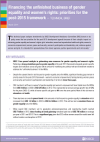FOUND 11
The report, authored by Professor Diane Elson, a leading feminist economist, makes a significant contribution to the advocacy work on the transparency of budgets. It provides arguments for increasing the accountability of government budgets to women's rights.
A summary guide for policy makers, gender equality and human rights advocates" is a publication based on a report by Diane Elson "Budgeting for Women's Rights: Monitoring Government Budgets for Compliance with CEDAW" by UNIFEM 2006.
Budgeting for Women's Rights Monitoring Government Budgets for Compliance with CEDAW: summary..(Fr )
A summary guide for policy makers, gender equality and human rights advocates" is a publication based on a report by Diane Elson "Budgeting for Women's Rights: Monitoring Government Budgets for Compliance with CEDAW" by UNIFEM 2006.
This book aims to contribute to the evolving understanding of public expenditure management as a political, rather than a purely technical, process. In particular, it explores the ways in which a rights approach can contribute to strengthening pro-poor voice and outcomes in budget processes.
Paper discussing the definition and measurement of Sustainable Development Goal (SDG) Indicator 5.c.1. (reclassified to Tier II) and comparing Indicator 5.c.1 with other SDG fiscal indicators.
This note provides an overview of existing gender equality markers and reviews issues relating to the tracking and monitoring of investments related to gender equality and women’s empowerment.
This technical paper analyses investments by OECD Development Assistance Committee (DAC) donors in six policy areas that are priorities for the post-2015 development agenda because of their catalytic impact on achieving gender equality and women’s rights: girls’ education; sexual and reproductive he
The guidance note sets out commom principles and standards for gender equality markers systems that track and report on allocations and expenditures for gender equality and women's empowerment.
The Global Programme Increasing Accountability in Financing for Gender Equality’ was developed to increase financing for national gender equality commitments in sixteen countries and to strengthen government and donor accountability on financing decisions and practices.
The ITC/ILO gender marker is a one-digit code (on a 0 to 3 scale) used by ITC to assess ;whether or not ITC/ILO ;training activities are designed in a gender-sensitive way in order to address the needs of women and men as ultimate beneficiaries of development actions.The application of the marker i





